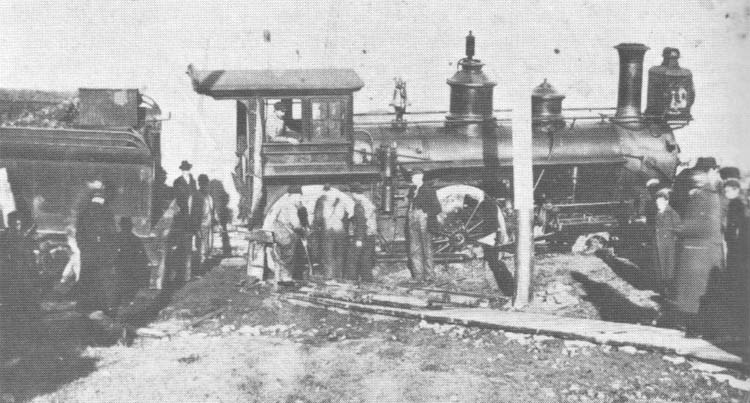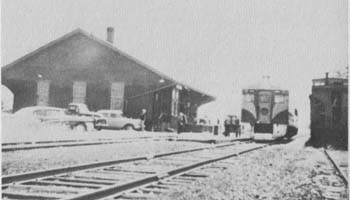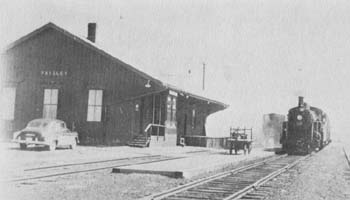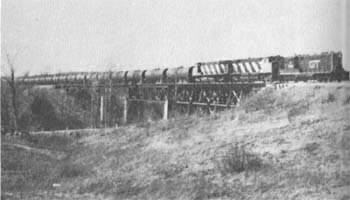
- Home
- Introduction
- History Speaks
- Transportation
- Public Services
- Commerce
- Sports
- Miscellaneous Stuff

|
Trains
|
From the Oct. 23, 1969 edition of the
There is no record as to when the station itself was built or opened, but the Advocate of September 9, 1909, commented that “Paisley's old-time red station” had been repainted. For many years, too, the platform fronting the building was elevated on stout cedar posts to the level of the station floor. In relatively recent years, the posts were removed and the platform lowered to track level; patrons then entered the station by a short flight of steps. The station was closed Oct. 24, 1969. Some equipment and train order signals were removed soon afterwards, and tickets on the Dayliner were to be procured from the conductor or, if preferred, could be purchased by telephone from Palmerston on a charge account, if the purchaser was listed in the telephone directory. Passenger service was discontinued altogether November 1, 1970. At one time there were two grain elevators, one to the north and one to the south of the station. These were torn down a number of years ago. Near the stock yards was another large building for storing grain. Several coal sheds along the east siding, south of the station, remained until the oil burning era. The bridge spanning the Teeswater River had always been a problem for the engineering staff. It is probable the first bridge was a timber trestle. This was replaced by one ofthe longest bridges in the province. It was almost 800 feet long. By modern standards this trestle was flimsy and weak. with the advent of heavier locomotives and heavier types of freight, reinforcement became essential
|
 Holding the shovel below the Engineer is Section Foreman Donald Thompson |
Submitted by Mr. R.A. Ernst, Manager of Telecommunications at Landon. Recently I came across an old timetable for the Great Western Railway and some of the information may be of interests. The trip from Toronto to Hamilton was via a Toronto railway service (the name of the railway is not shown), from Hamilton to Guelph via Great Western Railway and from Guelph to Paisley via Great Western Railway on the rails of :he Wellington Grey and Bruce Railway. Also mentioned in this timetable was :he fact that all trains operate on ‘Hamilton Ontario time'. The railway cars of :he Great West Railway at the time were painted canary yellow.
|
GTR Bridge over the Teeswater River circa |
The Station Bus In 1925 Mr. John S. Campbell bought the bus and dray business from Mr. Ed Dudgeon. Many “old Timers” will remember riding to or from the C.N.R. Station in this bus. Fare one way was only 25¢. In winter the bus was equipped with runners and in summer the runners were replaced with wheels. Pictured driving the team is Mr. Offie McTeer who worked for Mr. Campbell for many years. |
|
50 Years Ago February 27, 1924 The worst storm since 1918 stalled Thursday morning's train at the Christie farm, just this side of Turner's station, until Friday afternoon. A crew of about 60 shovellers was picked up at points from Palmerston north and accompanied a snowplow to Turner's and was kept working night and day until the train was released. Mr. and Mrs. Adam Munro undertook the contract of boarding the passengers and workers. Mr. Munro has a general store a few rods from the station and besides having a quarter of beef, cured hams and potatoes, there was a stock of canned goods on the shelves. Boxes of bread were commandeered from the train and milk was brought from nearby farms. The eaters were served in relays. The passengers slept on the train, which moved out about noon, but ran into another impassable bank a couple of miles from Turner's and stood there until the shovel gang cleared the way. 70 Years Ago March 3, 1904 The storms continued and no trains from the south had been able to reach Paisley in over a week. As a result the Advocate was again able to produce only four pages of this issue. |
|
|
|
 Last passenger service, Oct 31, 1970 |
 Last Steam Locamotive to arrive at Paisley |
 The Oil Train from Douglas Point |
| Return to top of Page | Return to top of Page |